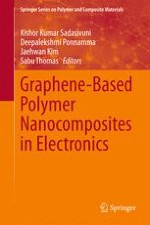This book covers graphene reinforced polymers, which are useful in electronic applications, including electrically conductive thermoplastics composites, thermosets and elastomers. It systematically introduces the reader to fundamental aspects and leads over to actual applications, such as sensor fabrication, electromagnetic interference shielding, optoelectronics, superconductivity, or memory chips. The book also describes dielectric and thermal behaviour of graphene polymer composites - properties which are essential to consider for the fabrication and production of these new electronic materials. The contributions in this book critically discuss the actual questions in the development and applications of graphene polymer composites. It will thus appeal to chemists, physicists, materials scientists as well as nano technologists, who are interested in the properties of graphene polymer composites.
